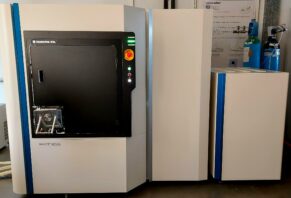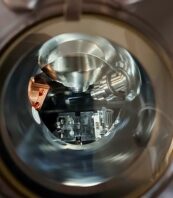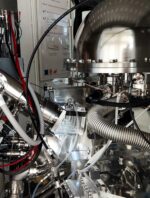X-ray photoelectron spectroscopy (XPS)
Our laboratory is equipped with the latest generation of XPS (PHI GENESIS developed by Physical Electronics) to meet the challenges of surface characterization.
The PHI Genesis offers high sensitivity and throughput for both large and small surfaces, thanks in particular to its micro-focused scanning X-ray source (5 µm). It also includes ion (Argon) sputtering guns:
- monoatomic for in-depth profiling of inorganic materials
- cluster for profiling polymers and hybrid materials.
It enables precise determination of the atomic composition and chemical environment of surface elements in solid materials (5-10 nm deep), including insulators, organics, polymers, powders, metals and glasses.
These features make it an essential tool for studying today's advanced materials, and for meeting your characterization and failure resolution needs:
- Corrosion problems
- Identification of contamination
- Stack analysis (composition and thickness)
- catalytic properties ...
More details :
- Micro-focused source :
PHI's micro-focused source provides X-ray-induced secondary electron (SXI) images generated by scanning a focused beam of less than 5 μm across the sample surface.
Like SEM, SXI can be used to navigate to areas of interest and select points for analysis in real time. SXI images offer a powerful tool for locating small characteristic areas of interest for analysis, contamination and inhomogeneities.
- Material profiling:
The standard monoatomic Ar gun can generate Ar+ ion beams from 5 eV to 5 keV and is ideally suited to most inorganic material profiling applications.
It's well known that Ar monoatomic ion guns generally cause severe chemical damage when spraying most polymeric and organic materials. That's why the Genesis is equipped with a 20 kV Argon Aggregate Gun (GCIB) for in-depth profiling of many polymer and organic films while minimizing the risk of chemical damage.
A focused X-ray beam, high-sensitivity spectrometer, high-performance floating column Argon ion gun, automated dual-beam charge neutralization, Zalar rotation, multi-point profiling capability within a single spray crater and advanced data reduction algorithms offer the highest-performance XPS profiling capability available.
Have a look at the Video presenting the equipment : Vidéo XPS
Our strengths
- Analysis of any material compatible with ultra-high vacuum, including insulators, organics, polymers, powders, metals and glasses.
- Determination of the elemental composition (except H and He)
- Quantitative and stoichiometric analysis with detection limits of around 0.1% atomic.
- Determination of chemical functions and oxidation states.
- Imaging with <5 µm spatial resolution (Scanning X-ray induced image).
- Depth composition profiling using an Ar gun for profiling most inorganic materials.
- Argon aggregate profiling of organic materials.


